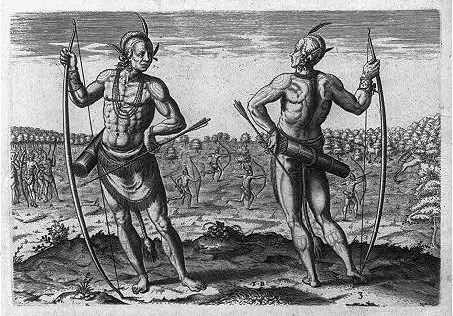Part of a series of articles titled Selections from Historic Contact: Early Relations Between Indian People and Colonists in Northeastern North America, 1524-1783.
Article
Understanding Northeastern Contact Part III

Collections of the Library of Congress, https://www.loc.gov/item/2001696964/
Selections from the National Historic Landmark Theme Study
By: Robert S. Grumet, National Park Service, 1992
Understanding Northeastern Contact Part III
These changes occurred as demographic shifts of unprecedented size and scope transfigured the Atlantic community. The already mentioned movement of millions of Europeans and Africans to the Northeast was part of a more massive series of migrations that began on or about the time of the first trans-Atlantic contacts. Epidemic contagions spread by migrants killed hundreds of thousands of people on both sides of the Atlantic. Bubonic plague from Asia joined with syphilis and other Western Hemisphere diseases to ravage Western Europe while Indian people struck by smallpox, measles, and other new maladies against which they had no natural immunities sickened and died in unnumbered thousands.
Countless thousands more were killed on both sides of the Atlantic in wars whose ferocity rose as technical, logistical, and tactical developments made violence a more efficient and lethal business. In Europe, struggles such as the Thirty Years War, which caused the deaths of as much as two-thirds of the entire German Rhineland population between 1618 and 1648, devastated entire regions. During the same period, colonists all but obliterated the Pequot of Connecticut and the Powhatan in Virginia as warriors of the Iroquois League of Five Nations depopulated much of the country surrounding their central New York homeland.
Although nations like the Iroquois were able to maintain their numbers for a time through wholesale adoptions of foreign tribesfolk and other means, Indian communities generally were not able to replace population losses as quickly as Europeans. No Indian community could draw upon the vast numbers of potential migrants available to the colonizing powers. Colonists settling along the Northeastern coast took advantage of this situation by establishing many of their first settlements on recently depopulated Indian lands. Chronicling this process, Francis Jennings has shown that while colonists naturally regarded the sparsely inhabited territories they moved to as “Virgin Land,” they actually were settling upon newly desolated “Widowed Lands” (Jennings 1975).
Last updated: May 21, 2019
